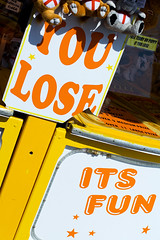I used to teach gadget workshops for kids in museums. There was one particular circuit that involved a potentiometer—transistor combination that, in its early iterations, had a tendency to cause minor explosions. And so I would start every workshop by saying, “if something starts to smoke, unplug your battery IMMEDIATELY.”
Looking through evaluations from many of these workshops, I was surprised to find that “smoking potentiometer” incidents educed better ratings of the workshop, not worse. Why might this be? First of all, your circuit setting on fire is funny, exciting, and something to be proud of. When your circuit doesn’t work for no discernable reason, it becomes an “I don’t get it” that feel disheartening. But if your circuit catches on fire, you DO get it, and you can show off to all your friends what happened. Kids whose circuits caught on fire didn’t feel like losers. They felt like players, engaged and ready to try again.
In fact, I’d argue that by saying “If something starts to smoke…” in the beginning of each workshop, I introduced an element of suspense to what otherwise might feel like a pretty “safe” activity—a museum program. I planted in their brains the possibility that this might not be easy, might not be hygienic, that they might lose.
At last year’s GDC, Jane McGonigal and co. presented the “top ten findings” from game research in 2005. Number 1 was about the importance of failure in games. According to Niklas Rajav from MIND Labs, players get more pleasure and excitement out of “active failure” than success. They found that attaining a goal decreases player arousal and interest. However, failure isn’t always fun. When the failure experience is “passive,” players disengage.
What is active failure? Think of simple egg or water balloon toss games. Failure in these games is physical, humorous, and public. There are some games out there with failure modes so “fun” that people try to attain them again and again. Dropping the lemmings off the cliff. Getting slimed. Watching your circuit go up in smoke. And there are other games that people love to participate in voyeuristically for the failure, not the win. Do people who watch American Idol or Survivor tune in to see who wins? Maybe at the end… but throughout the season, the excitement is in who gets axed.
Frank Oppenheimer famously said, “No one ever fails a museum.” In the context of test-taking, this is a great sentiment that promotes inclusion and exploration over judgment and right answers. But in the context of gaming, it may be a disappointment. Designers strive to encourage “successful” visitor experiences. But by not acknowledging and designing the non-success experience, visitors often either feel a lack of challenge (because the goal attainment feels trivial) or they disengage (because the failure experience is passive).
Designing good failure modes that are funny, instructive, fair, and supportive, can increase visitor interest and engagement with interactives. There are many interactives, especially in science museums, which only give feedback when you are successful. But if we start to think of these visitor interactions as game interactions, we can talk about introducing suspense and potential for failure—which can make the experience, ultimately, more successful. So next time I can’t get the power grid correctly distributed, let me watch the city fry. I’ll laugh, I’ll get it, and I’ll try again.
Friday, April 06, 2007
Subscribe to:
Post Comments (Atom)


2 comments, add yours!:
Fascinating! I think you described an important aspect of exhibit design that's lacking: especially in terms of computer interactives. I'm in an educational interaction design class right now and the problem with many educational games is that they're too scared of imitating popular entertainment software in terms of game mechanics--but it's the entertainment titles that do "active failing" so well!
Oh and this is so being linked to at sciencecentr.org!
Post a Comment